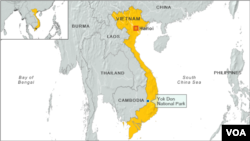HANOI —
At the end of the war in 1975, as many as 2,000 wild elephants roamed the lowland forests of Vietnam.
Today, there are as few as 50. Poaching and habitat destruction have brought the animals to the brink of extinction, and conservationists say the only herd with a long-term chance of survival is located along the border separating Yok Don National Park and Cambodia.
According to park director Tran Van Thanh, the already limited forests are shrinking as local communities cut trees in order to grow crops and expand housing.
“Another problem with the elephants now is about the agriculture cultivating of the local people," he said, explaining that the pachyderms enjoy eating sweet crops such as banana and dragon fruit, wreaking havoc on local farmers.
As their habitat shrinks, the elephants become more aggressive, he says, and traditional scare tactics, such as lighting fires, become less effective.
Because locals are not taught how to live in harmony with the elephants, Thanh says they often resort to violence. Many residents own guns, he adds, and illegal hunting is not uncommon.
“I think this is a big problem for the government," said Thanh, explaining that, after years of fighting illegal logging, staff training is outmoded. "They have to improve the capacity of the staff and [teach] the local authority how to help conservation."
Global ivory trade takes toll
But diminishing local resources isn't the only threat elephants are facing. Despite the 1989 global ban on illicit ivory, the global trade continues to take its toll on Vietnam's wild elephant population. In Dak Lak province, at least six wild elephants were killed by poachers this year alone — two of them found in August, their skulls mutilated and tusks sawn off.
Vietnamese authorities suspect the tusks may have been smuggled into China or perhaps to neighboring Thailand, where comparatively large quantities of ivory are available for sale.
But in China, despite stringent laws and customs enforcement, increasing consumer demand for ivory has been blamed for the slaughter of elephants worldwide.
“As consumers in China are acquiring more wealth, and increasingly spending that wealth, the demand for ivory is basically increasing," said Julian Blanc of CITES, the Convention on International Trade in Endangered Species of Wild Fauna and Flora.
"Ivory is obviously something which is highly valued by the Chinese people and that is what is driving the trend," he added. "But even if there wasn’t any demand from China, there would always be some background level of
poaching."
While a single kilogram of ivory can bring thousands of dollars on China's black market in endangered species, demand for the material as a symbol of wealth persists in Vietnam.
“[We] received reports of a number of houses, one in particular in Hanoi, where very large tusks have been displayed on the walls," said Richard Thomas of TRAFFIC, a wildlife trade monitoring network. "They haven’t been concealed from public view — people can see them when the curtains are open and the lights are on.”
While Vietnam's consumer demand for ivory doesn't appear to be increasing, government programs designed to protect the wild elephant have not been implemented.
In 2006, officials in Hanoi promised an urgent action plan that included the proposed construction of electric fences to safeguard the country's wild elephants. Stalled by insufficient funding, however, the program, which was slated to run until 2020, may kick in too late to save Vietnam’s elephants.





